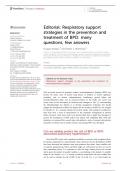EDITED AND REVIEWED BY
Eugene Dempsey,
University College Cork, Ireland
*CORRESPONDENCE
Huayan Zhang
zhangh@chop.edu
Robin McKinney
robin.mckinney@lifespan.org
RECEIVED 02 June 2023
ACCEPTED 03 July 2023
PUBLISHED 12 July 2023
CITATION
Zhang H and McKinney RL (2023) Editorial:
Respiratory support strategies in the prevention
and treatment of BPD: many questions, few
answers.
Front. Pediatr. 11:1233810.
doi: 10.3389/fped.2023.1233810
COPYRIGHT
© 2023 Zhang and McKinney. This is an open-
access article distributed under the terms of the
Creative Commons Attribution License (CC BY) .
The use, distribution or reproduction in other
forums is permitted, provided the original
author(s) and the copyright owner(s) are
credited and that the original publication in this
journal is cited, in accordance with accepted
academic practice. No use, distribution or
reproduction is permitted which does not
comply with these terms.Editorial: Respiratory support
strategies in the prevention and
treatment of BPD: many
questions, few answers
Huayan Zhang1,2*and Robin L. McKinney3*
1Division of Neonatology and Center for Newborn Care, Guangzhou Women and Children ’s Medical
Center, Guangzhou, China,2Division of Neonatology, Children ’s Hospital of Philadelphia and University of
Pennsylvania Perelman School of Medicine, Philadelphia, PA, United States,3Department of Pediatrics,
Alpert Medical School of Brown University, Providence, RI, United States
KEYWORDS
bronchopulmonary dysplasia, pulmonary hypertension (PAH), chronic mechanical ventilation,
non-invasive respiratory support (NIRS), chronic lung disease of prematurity
Editorial on the Research Topic
Respiratory support strategies in the prevention and treatment of
bronchopulmonary dysplasia
With increased survival of premature infants, bronchopulmonary dysplasia (BPD), has
become the major cause of chronic lung disease in children. It confers signi ficant
morbidity, such as chronic cardiopulmonary insuf ficiency, growth failure and
neurodevelopmental delay, and an increased burden on the health care system and
society. Since its first description by Northway and colleagues in 1967 ( 1), understanding
the pathophysiology has allowed us to develop management techniques that should
mitigate the development of BPD, but despite this the incidence of BPD has not changed
for decades ( 2). As a mainstay therapy for preterm infants with respiratory insuf ficiency,
there have been a series of advancements in the respiratory management of preterm
infants. However, much more needs to be learned about how to apply these therapies to
prevent the development of BPD and/or treat infants with established BPD. With this
realization, we proposed this research topic and gathered a team of neonatal and pediatric
specialists to examine ways to predict, prevent, and manage BPD once developed.
Can we reliably predict the risk of BPD or BPD-
associated pulmonary hypertension?
Given that BPD carries with it signi ficant morbidity in survivors, early recognition allows
the clinician opportunity to council families. Many risk factors for the development of BPD
have been discovered and explored, some more pertinent than others. Some variables such
as small for gestational age (SGA) and birth weight are well known, but they are not the
only contributing factors. It is important to take the larger clinical picture into account
which, given the number of possible variables, is overwhelming at the bedside. To simplify
things for the clinician, Yin et al. provide a predictive model based off seven variables that
can be used to calculate the risk of BPD at day 14 of life ( Yin et al. ). Such models areTYPE Editorial
PUBLISHED 12 July 2023| DOI10.3389/fped.2023.1233810
Frontiers in Pediatrics 01 frontiersin.org




